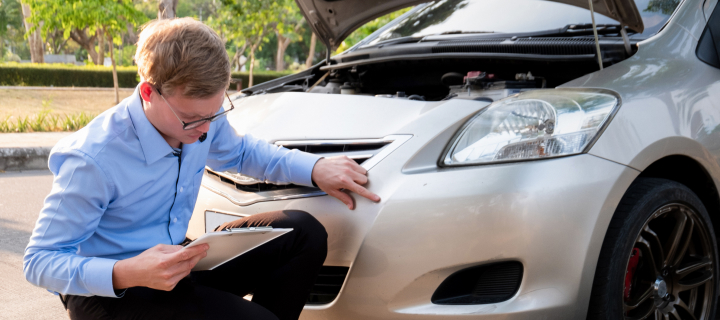Types of Car Insurance
Save up to 30% Online Today!
What do you think of when you hear the term car insurance?
Most of us just visualize it as that annoying bill that comes in the mail each month. But if you look a little closer, you will notice many different aspects of your car insurance that affect what you pay.
And different types of insurance come with different costs and different coverage. Unfortunately, the average driver doesn’t know nearly enough about car insurance to drive around safely and without breaking the bank.
Interested in learning more about car insurance? Keep reading to learn more about different types of insurance and how you can better protect yourself and your car.
What Are the Different Types of Car Insurance in California?
How many different types of car insurance are available to you in California? The truth is that there is special car insurance for almost every car and scenario. But for the average driver, there are only five types of car insurance you need to worry about.
What types of car insurance are we talking about? These types include:
- Bodily injury liability
- Property damage liability
- Collision
- Comprehensive car insurance
- Medical payment or personal injury protection
Keep reading to learn more about each type of insurance and whether you need it for your vehicle.
Bodily Harm and Property Damage Liability Insurance in California
Ever hear people talk about the minimum insurance requirements for California? The cornerstone of minimum coverage is almost always your liability insurance.
As the name implies, liability insurance is designed to protect you in the event of accidents that you are liable for causing. If you are found at fault, then there may be some major bills you need to pay, and liability insurance will help you pay them.

Even though it is the legal minimum in most states, you may be tempted to ask why liability insurance is so important. The short answer is that the costs you face in an accident where you are at fault can ruin your life. It is not uncommon for drivers to lose their savings, and even their home, to pay for damages that good liability insurance would have minimized.
Breaking Down Liability Insurance
Now, we typically discuss “liability insurance” as one thing. In reality, this is the combination of two kinds of insurance: bodily injury liability coverage and property damage liability coverage.
The good news is that liability insurance can significantly reduce the amount you have to pay in the event of an accident. The bad news is that, like most insurance plans, you will need to meet the deductible amount before the insurance begins paying out.
Different states will specify the minimum coverage required for your insurance. For example, California requires 15/30/5 minimum coverage. This means that you will need at least:
- $15,000 per person per accident
- $30,000 total per accident
- $5,000 for property damage per accident
These numbers represent the maximum amount of coverage your insurance will pay out. It is possible (and even encouraged) to get more than the minimum coverage. However, higher coverage amounts will result in a higher bill you must pay each month.
Collision Coverage in California
Collision and comprehensive coverage are other types of insurance you can take out. These types of insurance are designed to protect your car in the event of an accident, no matter who was at fault.
For example, liability coverage helps pay for damage when you are at fault. And if the other party is at fault, their liability coverage will cover the costs. But what if they don’t have enough insurance, or maybe no insurance at all?
This is where these additional types of insurance come in. Collision insurance helps pay for damages to your car regardless of who was at fault. This includes accidents that you cause: nobody’s liability insurance will cover the cost if you were to drive your vehicle into a telephone pole or other obstruction, but collision coverage can help pay for repairs.
Comprehensive Coverage in California
What about comprehensive coverage? Many drivers mistakenly think that their insurance will automatically protect against things like theft, vandalism, and hail. But the truth is that you’ll need comprehensive coverage to help protect your car against other events that your basic insurance plan didn’t cover. For example, comprehensive insurance can protect your vehicle against things like vandalism, theft, or weather-related incidents (such as hail damaging your car during inclement weather).
Sounds great, right? But keep in mind that both collision and comprehensive coverage have their own deductibles you must meet before they pay out. And the more insurance coverage you have (and the higher your limits are) will ultimately influence how much your monthly insurance cost is.
Medical Payments Coverage in California
Medical payments coverage (MedPay) is another type of insurance you can optionally take out. Like personal injury protection (PIP), this is designed to cover your medical bills and the medical bills of your passengers in the event of an accident. However, there are subtle differences between MedPay and PIP, and our guide will help you understand what these differences are.

As long as you already have liability insurance, you can take out MedPay. One of the best things about this type of insurance is that it doesn’t have any kind of annoying deductible or copay. And it can even help cover the medical expenses of any of your passengers that have little (or no) health insurance.
The Limits of MedPay
But what can MedPay actually pay for? Generally, this type of insurance helps pay for your medical bills, copays, deductibles, and other out-of-pocket expenses. It will do the same for other passengers in your car in the event of an accident.
However, MedPay is not an unlimited resource. There will be payout limits per person you need to understand. As always, it’s important to review your policy so you know these important details.
Personal Injury Protection in California
Personal injury protection works like an enhanced version of MedPay. Like MedPay, PIP will cover things like medical bills, copays, deductibles, and out-of-pocket expenses related to a car accident.
Why, then, would a driver take PIP over MedPay? It’s because PIP offers additional coverage beyond that, including coverage for funeral expenses, household expenses, childcare expenses, survivor’s loss expenses, and lost wages.
Interestingly, PIP offers protection even when you aren’t behind the wheel. For example, if you were hit by a car while walking across the street or walking through a parking lot, you could count on PIP to help with any related expenses.
Because it covers funeral expenses, many people take out PIP as an alternative to taking out a more traditional life insurance plan. This gives them peace of mind that comes from knowing their death will not leave the family in serious debt.
Understanding What “Full Coverage” Means
One of the terms your insurance carrier may use is “full coverage.” But what does full coverage mean in the context of your own car insurance policies and costs?
Despite the name, “full coverage” doesn’t mean you are insured against every possible scenario. Instead, it means you have a policy that offers a mixture of liability, collision, and comprehensive coverage.
In other words, “full coverage” means you have gone well above the minimum requirements of the state of California. But you are still limited by the exact policies you take out. For example, most policies will not pay out if you are driving while intoxicated. And they are unlikely to pay out if you use a personal vehicle for business purposes and then cause an accident.
Long story short? Full coverage is a great plan for anyone and everyone who can afford it. But you should buy your policy with full awareness that not every situation is covered.
Underinsured Insurance in California
Remember when we said that if someone else causes an accident, their own liability insurance will pay for the damages? There is just one problem with that plan. If the other driver has the bare minimum insurance requirement, then the insurance may not be able to pay out enough to fully repair or replace your car.
This is where underinsured motorist insurance comes in. Put simply, this helps pay for damages to your car the other driver’s insurance could not pay for. This is mostly used to protect expensive luxury vehicles, though certain states may mandate that you buy an underinsured motorist insurance policy. However, California does not have that requirement, though it’s definitely recommended.
Uninsured Insurance in California
The other type of insurance you may want to take out is uninsured motorist insurance. While an underinsured motorist policy helps pay out if the other person has minimal liability insurance, an uninsured motorist policy pays out if the other driver has no insurance at all.
Most of the time, an uninsured motorist policy is optional. But you may want to strongly consider taking out this policy. A surprising number of drivers (one in eight, to be specific) have no car insurance. And even more, people may flee from the scene of an accident, meaning that you will be responsible for all costs unless that person is caught, even if they were insured.
Insurance for Unique Circumstances
We have reviewed some of the major types of insurance you need to know about. But as we said at the beginning, there are plenty of other types of insurance that are useful in very special scenarios.
For example, you can take out towing and labor insurance as well as emergency roadside assistance. Both of these are types of insurance designed to provide protection if your car is damaged on the road. While these plans are often useful, they work best for drivers who spend a lot of time driving around for vacations and other personal trips.

Speaking of travel, you can take out rental reimbursement insurance. This type of insurance helps pay for a rental car for you to travel around in while you wait for your original car to be repaired or replaced.
New car replacement is a type of insurance you may want to take out when you buy a new car. The name says it all: this type of insurance helps to replace your car in the event that it is damaged beyond repair.
Of course, collision coverage will also help pay for these costs. But unless you have a high coverage level, collision coverage may not be able to pay for the cost of a newer vehicle like replacement car insurance will.
Believe it or not, there is even special classic car insurance to protect your classic automobile. This is important because many classic cars are very valuable, and they may require expensive parts in the event the car needs to be repaired.
There are two other types of specialized car insurance we will review in more detail: GAP insurance and SR-22 insurance.
Guaranteed Auto Protection
Guaranteed Auto Protection insurance (also known as GAP insurance) is another policy that is popular with new car owners. That is because it helps to pay out in the event your car is totaled.
This is mostly useful if you are still making payments on the car. Remember, insurance is only going to pay out up to the current value of the car. This means that even after the payout, you may still owe money to the car dealer.
With GAP insurance, you can rest assured that you can pay the car loan off in the event of an accident that totals your vehicle.
SR-22 in California
Sometimes, drivers and insurance carriers alike will refer to “SR-22 insurance.” Strictly speaking, an SR-22 is not a kind of insurance. Instead, it is an endorsement that states can require high-risk drivers to get.
In other words, the SR-22 is paperwork you can present to the state of California if you are considered a high-risk driver. An SR-22 is usually required if you have received a DUI or DWI. But it can be required for things like reckless driving, driving without insurance, driving with a suspended license, and accidents where you are at fault.
An SR-22 may also be required if you have many other moving violations in your driving history. Keep in mind that many insurance carriers will not insure a high-risk driver. If you find someone who will sell you a policy, it is likely to have a very high cost, and you typically need to keep the policy and the SR-22 paperwork for a minimum of three years.
Get a Custom Insurance Quote Today!
Now you know more about the different types of insurance that are available. But do you know where to find the insurance that is best for you and your needs?
At Cost-U-Less, we offer different types of insurance at plans that are affordable and fair. Get started with a quote online, visit us at an office near you, or call us at 800-390-4071 for a quote.